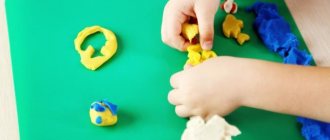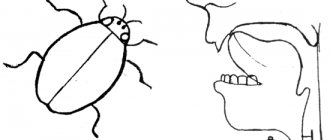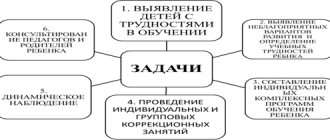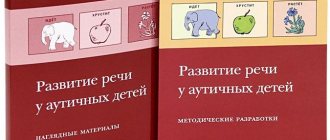Stages of work on sound educational and methodological material on correctional pedagogy (group) on the topic
Stages of working on sound
When forming correct sound pronunciation, it is proposed to comply with a number of general requirements for the sequence of stages of speech therapy work. Stage I. Preparatory stage: · Development of auditory attention and phonemic perception of the generated sound; · Formation of articulatory (speech motor) skills and abilities (articulatory gymnastics). Stage II. Formation of primary pronunciation skills: - sound production; — sound automation; - differentiation of formed and mixed sounds. Stage III. Formation of communication skills (accurate use of speech sounds in all communication situations). Automation of the delivered sound must be carried out in a strict sequence: 1. automation of sound in syllables (direct, reverse, with a combination of consonants); 2. automation of sound in words (at the beginning of the word, in the middle, at the end); 3. automation of sound in sentences; 4. automation of sound in pure sayings and poetry; 5. automation of sound in short and then in long stories; 6. automation of sound in spoken language. In this system, the starting point is the syllable and its place in the word. Depending on the type of sound being made, in one case, first, direct syllables are taken, and then reverse ones (producing the sounds [Ш], [Ж], [С], [З]), and when producing the sound [P], the reverse syllables are first practiced, and then straight. For example, this is what the sequence of automation and differentiation of whistling sounds looks like. Sounds [C], [C'] - [З], [З']: 1. sound [C] in a direct stressed syllable at the beginning of a word. 2. sound [C] in a direct stressed syllable in the middle of a word. 3. sound [C] in a direct unstressed syllable at the beginning of a word. 4. sound [C] in a direct unstressed syllable in the middle of a word. 5. sound [C] in a direct syllable with a combination of consonants. 6. sound [C] in a reverse stressed syllable. 7. sound [C] in a reverse unstressed syllable. 8. sound [C] in various positions. 9. sound [C'] in stressed syllables. 10. sound [C'] in unstressed syllables. 11. sound [C'] with a combination of consonants. 12. Differentiation of the pronunciation of sounds [C] - [C']. 13. Sound [З] in a direct stressed syllable. 14. The sound [З] in a direct unstressed syllable and with a combination of consonants. 15. Sound [Z] in reverse syllables. 16. Sound [З'] in various positions. 17. Differentiation of the pronunciation of sounds [Z] - [Z']. 18. Differentiation of the pronunciation of sounds [C] - [C'] - [Z] - [Z']. Complication of lexical material within the framework of “isolated sound/text” occurs at each correctional lesson. At each lesson, tasks are given that require the child to make statements of varying independence (and, therefore, difficulty): conjugate, reflected repetition, independent naming, creative search for answers with grammatical formatting of statements.
Report “Stages of working on sound”
D O C L A D
“STAGES OF WORK ON SOUND”
(prepared by teacher-speech therapist Basanova L.A.)
Correction of sound pronunciation disorders in children with disabilities
tami is a long and complex process. The work of educating the correct
sound pronunciation is significantly complicated by the characteristic of students with disabilities.
limited capabilities, weakness of the closure function of the cerebral cortex
brain, difficulty in establishing new conditioned connections. Inertia of nervous processes
owls, poor switchability of excitation and inhibition manifests itself in such children
in the persistent, stereotypical reproduction of the most strengthened old connections, in
difficulties switching to new ones. As a result, incorrect pronunciation
sound in words is preserved even when the isolated pronunciation
The child can make sounds relatively easily. Children in correctional schools have the most
The introduction of sound into speech takes a long time, i.e. stage of sound automation. In this regard, in the process of speech therapy work, special attention must be paid to the reflection
botka of delivered sounds in speech in various situations of speech communication.
At all stages of work on sound, much attention is paid to the development of general
and speech motor skills, education of auditory perception, attention, memory, normal
tion of all those processes that underlie violations of sound pronunciation and
determine their characteristics in children with disabilities.
Preliminary stage
elimination of violations of sound pronunciation occurs most often in the first grade of a correctional school. This stage is longer
residential and is characterized by a qualitatively different content than in mass school
le. At this stage, the development of general, manual, speech motor skills, auditory
perception, attention, gnosis, mnesis. taking into account the features of prosodic com-
components of speech in children with disabilities, at this stage work is also carried out on correct speech breathing, on the formation of long-term swimming
exhale.
The development of manual motor skills is of great importance not only for activating re-
basic motor skills, but also to prepare students to master writing.
At the preliminary stage of correction of sound pronunciation disorders, it is recommended
There are various types of exercises aimed at developing dexterity, accuracy,
coordination, synchronization of finger movements.
General exercises included in various types are also conducted.
activities:
1. Constructing houses, madhouses, etc. from cubes, first according to a model, then from memory and at random.
Stages of learning correct pronunciation card file on speech therapy on the topic
Stages of learning correct sound pronunciation
Sound pronunciation training is carried out in accordance with the stages of work on sounds adopted in speech therapy.
Stage I, preparatory, involves preparing the speech apparatus to master speech sounds. It includes the preparation of the speech motor apparatus, its motor skills, speech hearing, and speech breathing.
Correct pronunciation of sounds depends on the activity of the speech apparatus as a whole and on the activity of the organs of articulation (Speech therapy // Edited by Prof. L. S. Volkopa. - M., 1989. - P. 521) (tongue, lips, soft palate, teeth etc.), on their mobility and flexibility, on the coordination of articulatory movements, their strength and accuracy. Thus, the sound r, which is difficult to pronounce, requires flexibility in the movements of the tongue and rapid vibration of its tip. Hissing sounds require a strong air stream, raising the tongue in the shape of a “bucket”, rounding the lips and pulling them slightly forward, etc.
Therefore, it is necessary to systematically exercise the organs of articulation, carry out exercises aimed at training the muscles of the tongue in order to give it the desired position; on the mobility of lips, jaws, cheeks, on the production of air flow, proper breathing.
In order to prepare the speech apparatus, various exercises are used, which are carried out mainly in the form of a game, which creates conditions for their repeated repetition.
Various sound pronunciation games help develop the motor skills of the articulatory apparatus: “Who is screaming?”, “What does it sound like?”, “Whose house?” etc. Onomatopoeia is used for the sound of the wind, the rumble of an airplane, the croaking of a crow, the buzzing of a beetle, the clatter of horse hooves, etc. The repetition of meaningless syllables (sha - sho - shu, ra - ro - ru) quickly tires and does not give positive results, while while the child never gets tired of clicking his tongue “like a coachman,” buzzing “like a bee,” humming “like a steam locomotive.” In this regard, it should be noted that children acquire speech by imitating people, and not by the sounds of nature, the mooing of a cow, etc., i.e. imitation of animal sounds is carried out indirectly, through the speech of the teacher.
To develop speech breathing, blowing games are played: blowing off snowflakes (pieces of cotton wool), blowing up pencils, floating fish, and boats. However, children do not immediately cope with the task. Many people tense up, puff out their cheeks and cannot blow away the fluff that lies there. Children need to be taught this. From simple games they move on to more complex ones, where a strong air stream is required - children are asked to blow on ducks, geese, and a boat floating in the water; blow on the water until it splashes.
In the process of breathing exercises, the child learns to breathe correctly, to take a short, quick breath and a long, strong, smooth exhalation. Children should not be allowed to become tense and tired. Exercises are carried out sitting, no more than 1.5 minutes (starting from 0.5 minutes).
For the development of speech hearing and auditory attention, the games “Guess who called?”, “Guess what I said?”, “What is Parsley doing?”, “Echo”, etc. are recommended.
In individual work, articulatory gymnastics are used: licking the upper and lower lips with the tongue (licking honey); the tongue is made into a “sting”, “wide spatula”, etc.
Stage II - the formation of speech sounds, or sound production. This is the creation of a new neural connection between auditory (perception of a spoken sound), motor-kinesthetic (independent sound reproduction) and visual (visual perception of sound articulation) sensations. In most cases, it is necessary to simultaneously inhibit the incorrect connection between the idea of sound and its pronunciation (Pravdina O. V. Essays on the pathology of speech and voice. - T. 1. - M., 1960.)
The production of sounds begins with sounds that are easy to articulate and ends with more difficult ones; their sequence is preserved for both frontal and individual work (hissing, whistling, r, l).
In the complete absence of sound or in its unstable pronunciation, which is often observed in preschoolers, it is often enough to fix the child’s attention on the sound. This is the so-called production of sound by imitation or evocation of sound. Education here is based on children’s imitation of the teacher’s speech and clear pronunciation of sounds. This training method can only be used in mild cases. Fixation of attention on the sound occurs due to the emphasis of the sound in the word, a longer and more intense pronunciation by the teacher and the child’s perception at that moment of its sound and articulation.
If it is impossible to make a sound based on imitation, use an explanation of the articulation of the desired sound and a sample of its pronunciation, accompanied by an exercise for the children.
The position of the teeth, lips and tongue when pronouncing a sound is explained in a way that is accessible to children. A sample is given and repeated by the children individually, first by those who pronounce it well (additional pronunciation sample), and then by those who have deficiencies. Finally, everyone repeats the sound in unison.
During the period of sound formation, you need to be attentive to its appearance. You should constantly support the new sound and create the necessary conditions. The teacher needs to listen to the children’s pronunciation. In case of sound disturbances, the teacher reminds the essential points of its articulation and gives a sample of correct speech.
For exercises, it is necessary to give children new speech material, since poems and pictures that are well known to the child will evoke in him the old, familiar pronunciation of sounds.
Stage III – consolidation and automation of sounds. From the point of view of higher nervous activity, sound automation is the introduction of a newly created and consolidated relatively simple connection - speech sound - into more complex sequential speech structures - into words and phrases in which a given sound is either skipped completely or pronounced incorrectly (O.V. Pravdina).
Work at this stage can be considered as inhibiting old incorrect dynamic stereotypes and developing new ones.
This is difficult work for the nervous system. It requires great caution and gradualism, which is ensured by the accessibility and systematicity of speech material (the transition from an isolated sound pronounced to the inclusion of this sound in a sound combination, word, phrase). The sound is given in different sound combinations, at the beginning of the word, in the middle, at the end. First, easier conditions are created for sound pronunciation (a sound in an open syllable, in combination with two vowels, in a closed syllable), then they become more complex.
During this period, a combination of new material with old is useful. Monitoring children's speech and control exercises (retelling stories, telling stories based on a picture) are important. To consolidate and automate a new sound, systematic training is required, creating such conditions that the child pronounces it at least 10–20 times during the day. The teacher, by showing articulation and reminding him of his previous instructions, helps the child master speech skills.
The newly appeared sound must be supported by all means (child's approval, encouragement, etc.). Greater stability of sound is ensured by the use of different analyzers: auditory - as a leading analyzer, visual (showing articulation), tactile-vibrational (feeling the trembling of the larynx with the hand), tactile (feeling elongated lips with your fingers), kinesthetic (feeling the tip of the tongue trembling with the sound r).
Stage IV is the stage of differentiation of mixed sounds. It is based on differential inhibition. Work on the differentiation of sounds begins only when both mixed sounds can be correctly pronounced by the child in any combination and yet are not always used correctly and one sound is replaced by another.
Children do not distinguish a new sound from some sounds similar to it and confuse them (instead of drying - “shushka”, instead of Sasha - “Shasha”).
To differentiate sound, an effective technique is to compare two articulation patterns and establish their differences. When comparing two sounds, you should not compare the correct sound with its distorted version.
It is recommended to conduct classes on differentiating sounds using play material available to children. So, you can select pictures by category: clothes, shoes, toys, flowers, vegetables, etc. The names of objects alternate mixed sounds (cherry - plum). First, children are given two pictures, then, complicating the game, the number of pictures is increased to three or four (fur coat - boots - hat; cat - dog - horse - pig). Next, children are offered separate pairs of words that denote objects that do not belong to the same group. Phonetically, these words differ in one sound (mustache - ears, mouse - cape). First, the word contains one of the differentiated sounds, then both sounds (rudder, eagle, arrow, Larisa), then a phrase, a sentence (Vera has a better pen than me), nursery rhymes, proverbs, poems (“The pigeons flew in and sat down near the ice hole ", "The bunny is gray in summer, white in winter") You can carry out exercises without pictures, using only vocabulary material (nose - knife, goat - leather, Yura - spinning top, box - bun). These words can be used in a game or conversation:
What do you call your cat? - Kitty Kitty!
How do you drive a sparrow out of the garden? - Shoo-shoo!
Thanks to such exercises, children begin to grasp the semantic difference between words faster and better. Then they move on to memorizing poems and simple sayings containing certain sounds necessary for differentiation.
At all stages of learning sound pronunciation, exercises in the form of games are recommended: with pictures, toys, onomatopoeia, with elements of movement, with singing; reading and memorizing poems, jokes, nursery rhymes, proverbs. Retelling short stories and telling with pictures, taking into account age and learning objectives, begins with the stage of sound automation.
Literature
Alekseeva M.M., Yashina B.I. Methods of speech development and teaching the native language of preschoolers: Proc. aid for students higher and Wednesday, ped. textbook establishments. — 3rd ed., stereotype. - M.: Publishing House, 2000. - 400 p.
Stages of learning correct sound pronunciation
Sound pronunciation training is carried out in accordance with the stages of work on sounds adopted in speech therapy.
Stage I is preparatory , which involves preparing the speech apparatus to master speech sounds. It includes the preparation of the speech motor apparatus, its motor skills, speech hearing, and speech breathing.
The correct pronunciation of sounds depends on the activity of the speech apparatus as a whole and on the activity of the organs of articulation (tongue, lips, soft palate, teeth, etc.), on their mobility and flexibility, on the coordination of articulatory movements, their strength and accuracy. Thus, the difficult sound P to pronounce requires flexibility in the movements of the tongue and rapid vibration of its tip. Hissing sounds require a strong air stream, raising the tongue in the shape of a “bucket”, rounding the lips and pulling them slightly forward, etc.
Therefore, it is necessary to systematically exercise the organs of articulation, carry out exercises aimed at training the muscles of the tongue in order to give it the desired position; on the mobility of lips, jaws, cheeks, on the production of air flow, proper breathing.
In order to prepare the speech apparatus, various exercises are used, which are carried out mainly in the form of a game, which creates conditions for their repeated repetition.
Various games on onomatopoeia serve to develop the motor skills of the articulatory apparatus: “Who is screaming?”, “What does it sound like?”, “Whose house?” etc. Onomatopoeia is used for the sound of the wind, the rumble of an airplane, the croaking of a crow, the buzzing of a beetle, the clatter of horse hooves, etc. The repetition of meaningless syllables (sha - sho - shu, ra - ro - ru) quickly tires and does not give positive results, while while the child never gets tired of clicking his tongue “like a coachman,” buzzing “like a bee,” humming “like a steam locomotive.” In this regard, it should be noted that children acquire speech by imitating people, and not by the sounds of nature, the lowing of a cow, etc., i.e., imitation of animal sounds is carried out indirectly, through the speech of the teacher.
To develop speech breathing, blowing games are played: blowing off snowflakes (pieces of cotton wool), blowing up pencils, floating fish, and boats. However, children do not immediately cope with the task. Many people tense up, puff out their cheeks and cannot blow away the fluff that lies there. Children need to be taught this. From simple games they move on to more complex ones, where a strong air stream is required - children are asked to blow on ducks, geese, and a boat floating in the water; blow on the water until it splashes.
In the process of breathing exercises, the child learns to breathe correctly, to take a short, quick breath and a long, strong, smooth exhalation. Children should not be allowed to become tense and tired. Exercises are carried out sitting, no more than 1.5 minutes (starting from 0.5 minutes).
For the development of speech hearing and auditory attention, the games “Guess who called?”, “Guess what I said?”, “What is Parsley doing?”, “Echo”, etc. are recommended.
In individual work, articulatory gymnastics are used: licking the upper and lower lips with the tongue (licking honey); the tongue is made into a “sting”, “wide spatula”, etc.
Stage II - formation of speech sounds, or sound production.
The production of sounds begins with sounds that are easy to articulate and ends with more difficult ones; their sequence is preserved for both frontal and individual work (hissing, whistling, r, l).
In the complete absence of sound or in its unstable pronunciation, which is often observed in preschoolers, it is often enough to fix the child’s attention on the sound. This is the so-called production of sound by imitation or evocation of sound. Education here is based on children’s imitation of the teacher’s speech and clear pronunciation of sounds. This training method can only be used in mild cases. Fixation of attention on the sound occurs due to the emphasis of the sound in the word, a longer and more intense pronunciation by the teacher and the child’s perception at that moment of its sound and articulation.
If it is impossible to make a sound based on imitation, use an explanation of the articulation of the desired sound and a sample of its pronunciation, accompanied by an exercise for the children.
The position of the teeth, lips and tongue when pronouncing a sound is explained in a way that is accessible to children. A sample is given and repeated by the children individually, first by those who pronounce it well (additional pronunciation sample), and then by those who have deficiencies. Finally, everyone repeats the sound in unison.
During the period of sound formation, you need to be attentive to its appearance. You should constantly support the new sound and create the necessary conditions. The teacher needs to listen to the children’s pronunciation. In case of sound disturbances, the teacher reminds the essential points of its articulation and gives a sample of correct speech.
For exercises, it is necessary to give children new speech material, since poems and pictures that are well known to the child will evoke in him the old, familiar pronunciation of sounds.
Stage III - consolidation and automation of sounds.
Work at this stage can be considered as inhibiting old incorrect dynamic stereotypes and developing new ones. This is difficult work for the nervous system. It requires great caution and gradualism, which is ensured by the accessibility and systematicity of speech material (the transition from an isolated sound pronounced to the inclusion of this sound in a sound combination, word, phrase). The sound is given in different sound combinations, at the beginning of the word, in the middle, at the end. First, easier conditions are created for sound pronunciation (a sound in an open syllable, in combination with two vowels, in a closed syllable), then they become more complex.
During this period, a combination of new material with old is useful. Monitoring children's speech and control exercises (retelling stories, telling stories based on a picture) are important. To consolidate and automate a new sound, systematic training is required, creating such conditions that the child pronounces it at least 10-20 times during the day. The teacher, by showing articulation and reminding him of his previous instructions, helps the child master speech skills.
The newly appeared sound must be supported by all means (child's approval, encouragement, etc.). Greater stability of sound is ensured by the use of different analyzers: auditory - as a leading analyzer, visual (showing articulation), tactile-vibrational (feeling the trembling of the larynx with the hand), tactile (feeling elongated lips with your fingers), kinesthetic (feeling the tip of the tongue trembling with the sound p).
Stage IV - stage of differentiation of mixed sounds.
. Work on the differentiation of sounds begins only when both mixed sounds can be correctly pronounced by the child in any combination and yet are not always used correctly and one sound is replaced by another.
Children do not distinguish a new sound from some sounds similar to it and confuse them (instead of drying - “shushka”, instead of Sasha - “Shasha”).
To differentiate sound, an effective technique is to compare two articulation patterns and establish their differences. When comparing two sounds, you should not compare the correct sound with its distorted version.
It is recommended to conduct classes on differentiating sounds using play material available to children. So, you can select pictures by category: clothes, shoes, toys, flowers, vegetables, etc. The names of objects alternate mixed sounds (cherry - plum). First, children are given two pictures, then, complicating the game, the number of pictures is increased to three or four (fur coat - boots - hat; cat - dog - horse - pig). Next, children are offered separate pairs of words that denote objects that do not belong to the same group. Phonetically, these words differ in one sound (mustache - ears, mouse - cape). First, the word contains one of the differentiated sounds, then both sounds (rudder, eagle, arrow, Larisa), then a phrase, a sentence (Vera has a better pen than me), nursery rhymes, proverbs, poems (“The pigeons flew in and sat down near the ice hole ", "The bunny is gray in summer, white in winter.") You can carry out exercises without pictures, using only vocabulary material (nose - knife, goat - leather, Yura - spinning top, box - bun
Thanks to such exercises, children begin to grasp the semantic difference between words faster and better. Then they move on to memorizing poems and simple sayings containing certain sounds necessary for differentiation.
At all stages of learning sound pronunciation, exercises in the form of games are recommended: with pictures, toys, onomatopoeia, with elements of movement, with singing; reading and memorizing poems, jokes, nursery rhymes, proverbs. Retelling short stories and telling with pictures, taking into account age and learning objectives, begins with the stage of sound automation.






